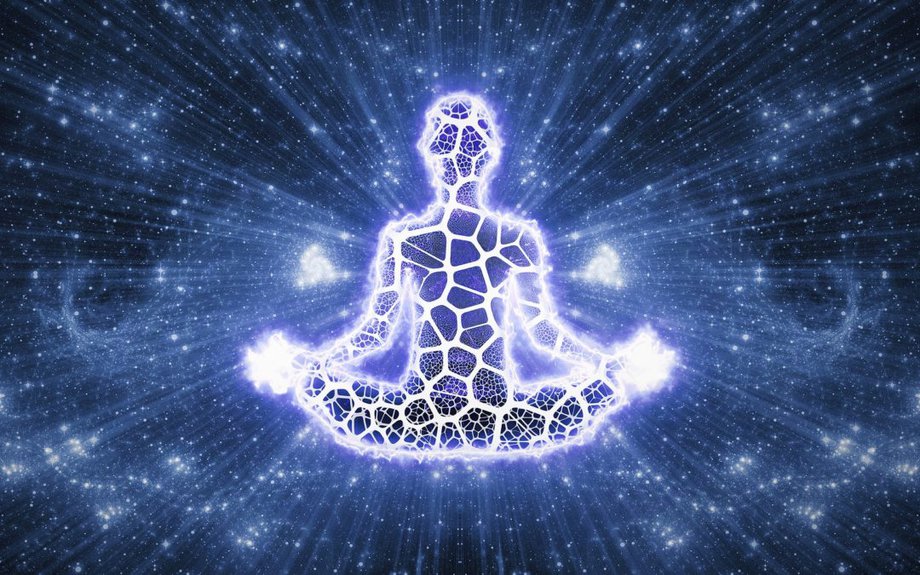Body-Mind Awareness Meditation and Embodied Presence: Techniques and Benefits

Are you looking to deepen your mind-body connection and enhance your overall well-being? Look no further.
In this article, we will explore the transformative practice of body-mind awareness meditation and the powerful benefits it brings. By cultivating awareness through meditation and incorporating techniques for embodied presence, you can tap into a greater sense of self and experience profound shifts in your mental and physical state.
Get ready to embark on a journey of self-discovery and inner peace.
Key Takeaways
- Body-mind awareness meditation deepens the understanding of the connection between the body and mind.
- Practicing body-mind awareness meditation cultivates awareness of the relationship between physical and mental states.
- Mindfulness brings benefits such as stress reduction and improved focus, leading to a balanced and fulfilling life.
- Movement-based mindfulness techniques, such as yoga and tai chi, promote mindfulness and enhance the mind-body connection.
The Connection Between Body and Mind
You can deepen your understanding of the connection between your body and mind through body-mind awareness meditation. By practicing this form of meditation, you can cultivate a greater sense of awareness and appreciation for the intricate relationship between your physical and mental states.
The mind-body connection is a fundamental aspect of holistic wellbeing, as it recognizes that our thoughts, emotions, and physical sensations are all interconnected. Through body-mind awareness meditation, you can learn to listen to the subtle signals and messages that your body sends to your mind, and vice versa.
This heightened awareness allows you to make conscious choices that support your overall wellbeing, both physically and mentally. By nurturing this mind-body connection, you can experience a greater sense of balance, harmony, and vitality in your life.
Cultivating Awareness Through Meditation
Are you interested in learning about the benefits of mindfulness and techniques for beginners?
Mindfulness can bring numerous benefits to your life, such as reducing stress, improving focus, and enhancing overall well-being.
As a beginner, it’s important to start with simple techniques like focused breathing or body scan meditation to develop your mindfulness practice.
Benefits of Mindfulness
One of the benefits of mindfulness is that it helps to reduce stress and anxiety. Incorporating mindfulness into your daily routine can have a positive impact on your overall well-being. Scientific research on mindfulness has shown that it can improve cognitive function, increase self-awareness, and enhance emotional regulation.
Here are three ways mindfulness can benefit you:
- Improved focus and concentration: Mindfulness practices, such as meditation, can help you train your mind to stay present and focused on the task at hand.
- Stress reduction: By practicing mindfulness, you can learn to observe your thoughts and emotions without judgment, which can help reduce stress and anxiety.
- Enhanced productivity: Mindfulness in the workplace has been found to increase job satisfaction, creativity, and overall productivity.
Incorporating mindfulness into your daily life can bring about numerous benefits, allowing you to live a more balanced and fulfilling life.
Techniques for Beginners
If you’re new to mindfulness, starting with simple breathing exercises can be an effective technique. By focusing on your breath, you can bring your attention to the present moment and calm your mind. Here are a few breathing techniques that you can try:
| Breathing Technique | Steps |
|---|---|
| Diaphragmatic breathing | 1. Sit in a comfortable position. 2. Place one hand on your belly and the other on your chest. 3. Take a deep breath in through your nose, filling your belly with air. 4. Exhale slowly through your mouth, emptying your belly completely. Repeat for several minutes. |
| Box breathing | 1. Inhale slowly through your nose for a count of four. 2. Hold your breath for a count of four. 3. Exhale slowly through your mouth for a count of four. 4. Hold your breath for a count of four. Repeat for several cycles. |
In addition to breathing techniques, visualization exercises can also help you cultivate mindfulness. Close your eyes and imagine yourself in a peaceful and calm environment. Visualize each detail, from the colors to the sounds. Allow yourself to fully immerse in this visualization, letting go of any distractions or thoughts. Practice these techniques regularly, and you will begin to experience the benefits of mindfulness in your daily life.
Techniques for Embodied Presence
In this discussion, we will explore techniques for cultivating embodied presence. We will focus on the breath and body connection, sensory awareness exercises, and movement-based mindfulness techniques.
By bringing attention to the breath and its connection to the body, you can develop a deeper sense of presence and grounding in the present moment. This involves being aware of the sensations of the breath as it enters and leaves your body, and noticing how it affects different parts of your body. By practicing this awareness regularly, you can cultivate a stronger mind-body connection and become more attuned to the present moment.
Additionally, engaging in sensory awareness exercises can help heighten your ability to fully experience and appreciate your surroundings. These exercises involve using your senses to explore the details of your environment, such as noticing the colors, textures, sounds, and smells around you. By actively engaging with your senses, you can bring yourself into the present moment and deepen your connection to the world around you.
Finally, incorporating movement-based mindfulness techniques into your practice can further enhance your mind-body connection and promote a greater sense of mindfulness in everyday activities. These techniques involve combining movement with mindful awareness, such as practicing yoga, tai chi, or walking meditation. By focusing on the sensations of your body as you move, you can bring a sense of mindfulness and presence to your physical actions.
Breath and Body Connection
Focus on your breath and feel the connection between your body and the rhythm of your inhales and exhales. This mindfulness technique allows you to bring your attention to the present moment and cultivate a sense of calm and clarity. As you focus on your breath, notice how your body moves with each inhale and exhale. It’s a powerful reminder of the deep interconnection between your mind and body.
Incorporate these simple meditation techniques into your practice to enhance your body-mind awareness:
- Body scan: Slowly scan your body from head to toe, noticing any sensations or areas of tension.
- Loving-kindness meditation: Direct kind and loving thoughts towards yourself and others.
- Walking meditation: Pay attention to each step as you walk, feeling the ground beneath your feet.
Sensory Awareness Exercises
Take a moment to fully engage your senses and notice the sights, sounds, smells, tastes, and textures surrounding you.
Mindfulness and stress reduction can be achieved through a practice called body scan meditation. This technique involves systematically bringing attention to different parts of your body, from head to toe, and noticing any sensations that arise.
As you focus on each body part, you become aware of any tension, discomfort, or even relaxation that may be present. This heightened sensory awareness allows you to tune in to the signals your body is sending, helping you to release tension and reduce stress.
Movement-Based Mindfulness Techniques
Engage your senses by incorporating movement into your mindfulness practice. Movement-based mindfulness allows you to cultivate a deeper connection between your body and mind. By integrating somatic practices, you can enhance your awareness and fully immerse yourself in the present moment.
Try these techniques to infuse movement into your mindfulness practice:
- Walking meditation: Take a slow, deliberate walk, focusing on each step and the sensations in your body.
- Yoga or Tai Chi: Flow through gentle movements, synchronizing your breath with each pose or posture.
- Dance meditation: Allow your body to move freely, expressing yourself through dance while staying attuned to your breath and sensations.
The Power of Breathwork in Body-Mind Awareness
Breathe deeply and let the power of breathwork guide you to a heightened sense of body-mind awareness. By practicing various breathwork techniques and breathing exercises, you can tap into the transformative power of your breath to cultivate a deeper connection between your mind and body.
Incorporating breathwork into your daily routine can have numerous benefits. It can help reduce stress, improve focus and concentration, enhance physical performance, and promote relaxation and calmness.
Here is a table highlighting three popular breathwork techniques and their benefits:
| Technique | Benefits |
|---|---|
| Diaphragmatic | Relieves stress and anxiety |
| Breathing | Improves lung capacity |
| ——————- | ———————————- |
| Alternate | Balances energy and harmonizes |
| Nostril Breathing | the mind and body |
| ——————- | ———————————- |
| Box Breathing | Enhances mental clarity and |
| promotes relaxation |
Incorporating these techniques into your daily life can help you harness the power of your breath to achieve a heightened sense of body-mind awareness. So take a deep breath, and let your breath guide you towards a more present and connected experience of life.
Exploring Sensations and Emotions in Meditation
As you delve deeper into your meditation practice, you will begin to explore the rich tapestry of sensations and emotions that arise within you. It’s a fascinating journey of self-discovery, where you become more attuned to the subtle nuances of your body and mind.
Here are a few things you might encounter along the way:
- Physical Sensations: You may notice tingling, warmth, or vibrations in different parts of your body. Pay attention to these sensations without judgment or attachment.
- Emotional Waves: Your meditation practice can also bring up a range of emotions – joy, sadness, anger, or even boredom. Allow yourself to feel these emotions fully, observing them without getting carried away.
- Energy Shifts: As you explore sensations and emotions, you may experience shifts in your energy levels. Notice any changes in your vitality or sense of aliveness.
Enhancing Mindfulness Through Movement
Take a moment to notice how your movement can serve as a gateway to deepening your mindfulness practice. Incorporating movement-based mindfulness into your routine can enhance your overall experience and bring a new level of awareness to your practice.
By engaging in gentle, intentional movements, such as yoga or walking meditation, you can cultivate a deeper connection between your body and mind. As you move, pay attention to the sensations in your body, the rhythm of your breath, and the present moment. This movement-based mindfulness allows you to explore the mind-body connection and brings you into a state of embodied presence.
Additionally, incorporating breathwork techniques during movement can help you further anchor your awareness in the present moment and deepen your sense of mindfulness.
Benefits of Body-Mind Awareness Meditation
Incorporating movement and breathwork into your mindfulness routine can deepen your connection to the present moment. It’s amazing how these simple practices can have such profound effects on your overall well-being.
Here are a few benefits you can experience by incorporating body-mind awareness meditation into your daily life:
- Improved focus: By bringing your attention to the sensations in your body and synchronizing your movements with your breath, you can train your mind to stay focused on the present moment. This can help improve your concentration and enhance your ability to stay present in all areas of your life.
- Reduced stress: Moving your body and connecting with your breath can have a calming effect on your nervous system. It can help release tension and reduce the levels of stress hormones in your body. Incorporating body-mind awareness meditation can provide you with a much-needed break from the chaos of everyday life and help you find a sense of calm and peace within.
Frequently Asked Questions
How Long Should I Meditate for Each Day to Experience the Benefits of Body-Mind Awareness?
To experience the benefits of body-mind awareness, you should meditate for a certain duration each day. The length of time will vary for each person, so find what works best for you.
Can Body-Mind Awareness Meditation Help With Chronic Pain Management?
Yes, body-mind awareness meditation can help with chronic pain management. By practicing mindfulness techniques, you can relieve the pain and improve your overall well-being.
Are There Any Specific Breathing Techniques That Can Be Used During Body-Mind Awareness Meditation?
During body-mind awareness meditation, you can use specific breathing techniques to enhance your practice. These techniques, combined with mindfulness techniques, can help you deepen your awareness and promote a sense of calm and relaxation.
Is It Necessary to Be Physically Fit or Flexible to Practice Body-Mind Awareness Meditation?
Being physically fit or flexible is not necessary to practice body-mind awareness meditation. The focus is on cultivating mindfulness and connecting with your body, regardless of your level of fitness or flexibility.
Can Body-Mind Awareness Meditation Improve Focus and Concentration in Daily Life Activities?
Yes, body-mind awareness meditation can improve your focus and enhance your concentration in daily activities. It helps you become more present, clear your mind, and be fully engaged in whatever you’re doing.







